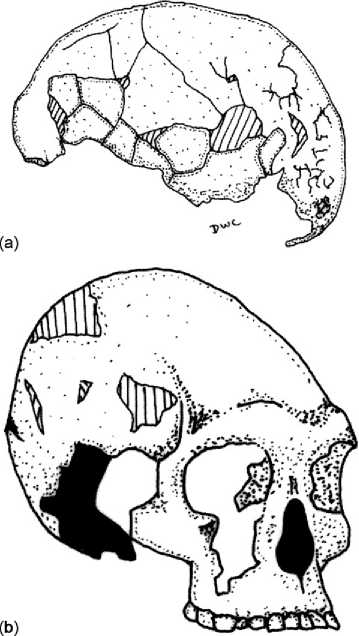Two main theories relate to the origins of the earliest Australians. The first is the multiregional model proposed by Wolpoff, Wu, and Thorne. They argue for an independent evolution of human groups in different regions of the world through time. This theory suggests that there is a continuation of anatomical form from Homo erectus of Java through to the first Australians. As such the original human colonization of Australia is said to have had two distinct migration episodes, the earlier migration of a ‘gracile’-like people, and the other later migration of a more ‘robust’-like people. The so-called ‘gracile populations’ (as represented by many of the Willandra Lakes fossils) are said to have originateD from present-day southern China, while the later ‘robust’ populations (like in Kow Swamp and Coobool Creek; Figure 1) are said to have originated from present-day Indonesia, from the H. erectus population.
The alternative hypothesis associated with the ‘Out of Africa’ hypothesis, as originally proposed by Brauer and Stringer, suggests that indigenous Australians are represented by one migration occurring around 60 000 years ago, with little significant biological contact after this initial colonization, that is, there was a recent origin of modern humans from Africa followed by a rapid biological dispersion throughout Europe and Asia, including Australia. These modern populations quickly replaced the original populations in Europe and Asia without any significant inbreeding; the demise of the more ‘archaic’ human populations occurred simply by their succumbing to the competition for the available resources with recently arrived modern humans.
The oldest Australian hominin fossils have so far been discovered at Lake Mungo (Figure 1); it is one of these specimens designated Lake Mungo 3 (LM3) that has now been dated to between 60 000 and 40 000 years ago. The Lake Mungo fossils are described as having a high frontal (forehead) and relatively thin cranial walls, the cranium is spherical in shape, the frontal lacks a supra-orbital torus (bony brow ridge), and the face is relatively flat and lies immediately below the frontal. In other words, this early population is truly modern (Figure 2a).
Apart from LM1, LM 3, and some other, much less complete, specimens from the Willandra Lakes, the main candidate for what the multiregionalists define as ‘gracile’ among the Australian fossils is the skull from Keilor (Figure 1). Keilor, in particular, is said by Thorne to resemble the cranium from Wajak in Java, some specimens from Ziyang in southern China dated to around 38 000 years ago, and Liujiang arguably dated at 67 000 years. The isolated incisor teeth from Liujiang are ‘shovel-shaped’ and this incisor morphology has often been argued to represent a regional trait linking Chinese H. erectus and modern East Asians. This feature, however, is also observed in Neanderthals, 400 000 year-old specimens of Homo heidelbergensis from Africa and Asia and even their presumed African ancestor Homo ergaster (around 2 million years ago), and their ancestor Australopithecus (around 3.5 million years ago). As such, it is simply a ‘primitive’ feature for the hominins and is not unique to the Australian-Chinese fossil hominins at all. Indeed, incisor-shoveling is not strongly developed in Aboriginal Australians, including the Keilor skull, so that if this ‘regional continuity’ character

Figure 2 LM and KS specimens. (a) Willandra hominin specimen 1 (Lake Mungo) from southern New South Wales. (b) Kow Swamp 1 from Victoria.
Was correct it would be evidence against a China-Australia link, not for it.
The so-called ‘robust’ Pleistocene Australians are argued by multiregionalists to include the skulls from Kow Swamp, Cohuna, and Coobool Creek, all apparently dating from about 9000 to 12 000 years ago (Figure 1). They are said to have large jaws and teeth, thick skull bones, prominent continuous brow ridges and, in particular, flat receding foreheads. The multiregionalists argue that these ‘robust’ fossils all demonstrate a continuity of morphological features with Javanese H. erectus, and share no physical and/ or genetic influence from the Pleistocene of Africa. Indeed, much of the entire multiregional scheme has been based on comparisons of Early Pleistocene Indonesian H. erectus specimens from Sangiran and the Late Pleistocene Australian modern human fossils from Kow Swamp (Figure 2b).
What of the other Australian fossils? One from the Willandra Lakes (WLH 50) (Figure 1), is indeed very robust, and has thicker skull bones than any from Kow Swamp and dates to 14 000 years ago. Recently, Wolpoff and colleagues have argued in depth that WLH50 provides evidence for a H. erectus-Australian lineage. Most, however, agree that the unusual cranial thickness and robusticity observed in WLH50 is the result of a pathological condition known as hemoglobinopathy. Therefore, while Wolpoff and colleagues spent considerable time analyzing WLH50, they were not able to rule out the possibility that WLH 50 may have suffered a pathological condition. As such, their suggested evolutionary sequence from H. erectus to Australia is based on one specimen, and one that is extremely problematic.
Another, from Cossack, Western Australia, is very large and appears to have a flat receding forehead, but it is distorted and compressed, so it is difficult to interpret its actual morphological shape. Nitchie, from western New South Wales, is very much like Keilor but has larger brow ridges, and this highlights a problem - the boundary between the two groups is not clearly delineated. Keilor, in fact, is every bit as large as any Kow Swamp individual, and has an enormous palate. Lake Mungo 3 has thick skull bones and large teeth, but is ‘gracile’ in shape. Both are very different from the tiny LM 1, the only one which is really ‘gracile’ at all (see below).
As far as the dates go, the ‘graciles’ appear earlier; LM1 and 3 are either 40 000 or 60 000 years old; Keilor is the latest Pleistocene (probably 10 000-20 000 years old). Of the ‘robusts’, WLH50 is 14 000 years old, the Kow Swamp specimens vary from 9000 to 12 000 years ago, and Coobool about the same, while Nitchie (if it truly belongs to this group) is only 6000. If the multiregionalists are correct, the ‘graciles’ arrived first, the ‘robusts’ much later.




 World History
World History









